This morning at 6:30 we were driven to the site of the 15 Moai on the north side of the island to watch the sun rise and to take decent photographs. They are only decent if a mass of tourists don’t show up in a bus and occupy space in your carefully designed photograph shoot. We were lucky. And the 15 Moai (restored by Japanese financiers) made excellent silhouettes in front of the colored sky.
Although I had planned to climb the second hardest mountain, Poike, in the afternoon, it was 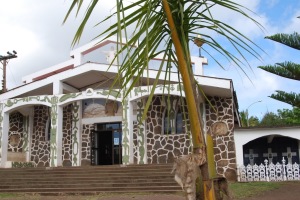 exchanged for an easy day for sore bones to round out little things I wanted to do, such as to photograph the cemetery (photo below) and the catholic church (photo on left) with the Rapa Nui symbols up and down it’s outside columns. We also went to the archaeolo
exchanged for an easy day for sore bones to round out little things I wanted to do, such as to photograph the cemetery (photo below) and the catholic church (photo on left) with the Rapa Nui symbols up and down it’s outside columns. We also went to the archaeolo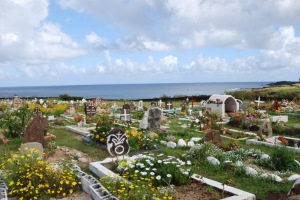 gical museum to put all the puzzles together, see the exciting female Moai, the excavated eye (big as my belly) made of white coral and red volcanic rock, and to buy a few books. A real find was the famed Kontiki author Thor Heyerdahl’s story of his visits and stay at Easter Island when he collected 600 items and removed them to Norway , and a book by Padre Sebastian Englert who in his mission became highly cognizant of the Rapa Nui culture. These two books, Nico my guide again today said, are filled with truth and not fantasies of foreign minds. (For the record, the British took a Moai to England for their museum and the French did likewise, but returned it.)
gical museum to put all the puzzles together, see the exciting female Moai, the excavated eye (big as my belly) made of white coral and red volcanic rock, and to buy a few books. A real find was the famed Kontiki author Thor Heyerdahl’s story of his visits and stay at Easter Island when he collected 600 items and removed them to Norway , and a book by Padre Sebastian Englert who in his mission became highly cognizant of the Rapa Nui culture. These two books, Nico my guide again today said, are filled with truth and not fantasies of foreign minds. (For the record, the British took a Moai to England for their museum and the French did likewise, but returned it.)
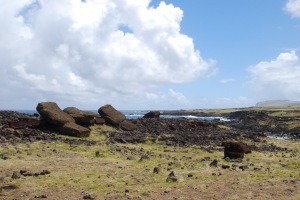
Photo: Moais fallen and flat as Gingerbread men.
The saddest sight to me is how many Moai had been placed (with much labor) on their appropriate ahu or platforms but were pushed over either by the rebels during the civil war in 1500 or by subsequent tsunamis, the most recent being 1960 when many of the ahu were wrecked. This afternoon as we drove to four sights of ahu actually on the edges of the bluffs, I was moved by how the fallen Moai, their faces smashed into the rock or earth, looked like gingerbread men baked by my grandchildren. Maybe with a spatula they could be lifted up again. However, nothing is touched, and restoration is not yet in progress at most of these sites. Once again the guide had to admonish a tourist unguided for standing on a fallen Moai part to take pictures. Singular tourists know little about the history and value of the Moai and the island and have no respect when they want a good photograph.
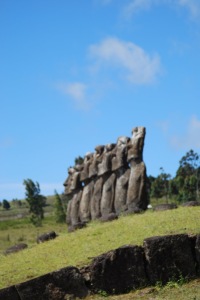 Another site we visited this afternoon contains seven Moai standing side by side and oddly facing toward the ocean, watching whatever might come by sea. There are pebbles in their ahu which came from the River Seine in France, having been found on a ship that sunk close by in the island and were used to help make the ahu. The legend has it that these seven represent the first seven explorers who came to Rapa Nui. They came from a big land called Hiva but the story says everything was destroyed and this giant land disappeared. (It could have been when all the earth’s land was joined together, and now, of course has broken apart into continents.) Matua, the spiritual advisor to king Hau Maka had a dream (heard that before? ) that his spirit came out of his body and arrived on undiscovered Rapa Nui. He put names on various places and then returned to his body. (Note. outer body experiences?) The next day he revealed his dream to the king who sent his seven best explorers to search the land. One dove into the sea to romp with a sea turtle and his ribs were broken by a whop from the turtles foot, so only six explorers arrived and planted vegetables and fruits for the king’s arrival. Sceptics find errors in the details, but these seven Moai are different from the rest, which face inland watching over the people around most of the sea edges of the island.
Another site we visited this afternoon contains seven Moai standing side by side and oddly facing toward the ocean, watching whatever might come by sea. There are pebbles in their ahu which came from the River Seine in France, having been found on a ship that sunk close by in the island and were used to help make the ahu. The legend has it that these seven represent the first seven explorers who came to Rapa Nui. They came from a big land called Hiva but the story says everything was destroyed and this giant land disappeared. (It could have been when all the earth’s land was joined together, and now, of course has broken apart into continents.) Matua, the spiritual advisor to king Hau Maka had a dream (heard that before? ) that his spirit came out of his body and arrived on undiscovered Rapa Nui. He put names on various places and then returned to his body. (Note. outer body experiences?) The next day he revealed his dream to the king who sent his seven best explorers to search the land. One dove into the sea to romp with a sea turtle and his ribs were broken by a whop from the turtles foot, so only six explorers arrived and planted vegetables and fruits for the king’s arrival. Sceptics find errors in the details, but these seven Moai are different from the rest, which face inland watching over the people around most of the sea edges of the island.
You ask, as I did many times, was there ever a pagan religion among the Rapa Nui, who are now very catholicized? The answer is always vague, as if no one really knows. Make Make, God the creator, is found in petroglyphs all over the island implying acknowlegement of some pantheon of gods. Make Make, the creator of man, only existed on Easter Island, not connected to Tane, the creator god of Polynesia. My guides often refered to “mana” which no one seemed to be able to identify, but it is probably represents the spirit of man, a mixture of the Buddhist karma idea and the Christian Holy Spirit. Rapa Nui gods and other divine creatures were incarnated in objects and animals, such as a god Tangaroa appeared in the body of a lizard.
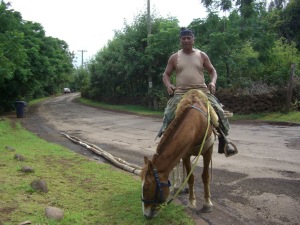 A final delight was a quick visit with Nico’s uncle, a character if there ever was one, whom we met as he was riding his horse home dragging behind two long eucalyptus poles. Now if that wasn’t a gas saver. In front of his house is a Moai he carved out of lava rock. It faces his home to protect him, and on the back of the Moai are symbols of the bird man and other local lore, copying the Moai ensconced in a British museum. It’s the only one with such carvings. Throughout his yard was about every kind of fruit tree on the island, and black plastic containers of seedlings of more fruits and vegetables to come – strawberries, sweet potatoes, and so forth. As he says, he plants in the morning, fishes in the afternoon and enjoys getting high at night. He has no children, no wives, and is a man of laughter and generosity as are so many on this amazing island.
A final delight was a quick visit with Nico’s uncle, a character if there ever was one, whom we met as he was riding his horse home dragging behind two long eucalyptus poles. Now if that wasn’t a gas saver. In front of his house is a Moai he carved out of lava rock. It faces his home to protect him, and on the back of the Moai are symbols of the bird man and other local lore, copying the Moai ensconced in a British museum. It’s the only one with such carvings. Throughout his yard was about every kind of fruit tree on the island, and black plastic containers of seedlings of more fruits and vegetables to come – strawberries, sweet potatoes, and so forth. As he says, he plants in the morning, fishes in the afternoon and enjoys getting high at night. He has no children, no wives, and is a man of laughter and generosity as are so many on this amazing island.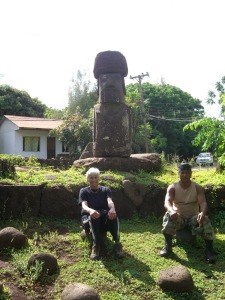 Photo: At the Moai of Nico’s Uncle.
Photo: At the Moai of Nico’s Uncle.

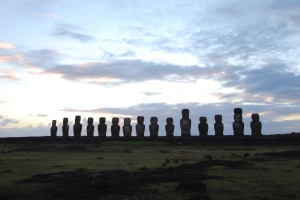
VERY informative post, both historically and recently…I will be going to Easter Island for the total eclipse of the sun as you mentioned. I would love to hear more stories about your trip to Easter Island and see more pictures! 🙂
I came to you from a google search of “mana.” I am reading up on Easter Island and have now read all of Jared Diamond’s section on it in Collapse and Padre Englert’s book Island at the Center of the World.
Actually, mana is the local word for island magic. I’m trying to find out more about that. The only example I’ve found of mana so far is the mana to transport the moai: The natives say that the moai were transported by turning the moai into living beings who could walk a little bit each day.
I’ll search further, on google and elsewhere, for more examples of mana.